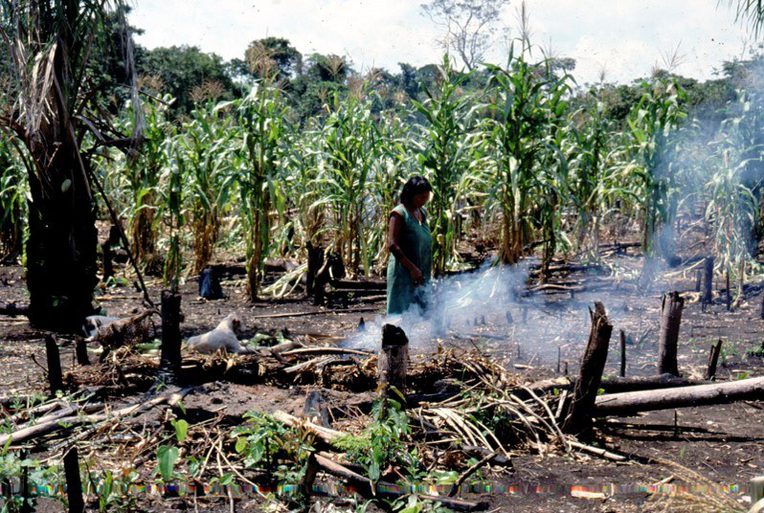Friendly Fire: Gendered Practices of the Kayapó and the Taming of Fire
From the Series: Firestorm: Critical Approaches to Forest Death and Life
From the Series: Firestorm: Critical Approaches to Forest Death and Life

Amazonia has been shaped by human fire over the last fifteen thousand years, but by friendly fire rather than the feral fire that now rampages through the dry season. The millennia of “social” burning in Amazonia worked to structure landscapes of mutuality, not to annihilate them. The current wildfire unleashed by speculators, ranchers, and land grabbers does not shape a complex system of mosaics of landscapes that work across a spectrum from domestication, semi domestication, to the wild, but rather produces biotic obliteration goaded on by climate change and the modernist rage for uniformity in the landscapes of tropical development. The recent calls for fire suppression reflect the “Bambi syndrome”: a worldview where, exiled from nature, humans and their minions extinguish balanced nature—a nature separate from people. This division of people from the natural world is a modern Western ontology. Most Indigenous and traditional Amazonian cultures view themselves “in the society of nature,” as a part of and in kinship with nature. Nature is also an actant, a nonhuman set of entities, processes, and networks that interact with and create socio-natures.
Harnessing large forces to create working landscapes—interventions in plant succession, soil processes, rivers, animal support, as well as fire—is well documented in the Amazonian repertoire. The history of Indigenous burning is a complex means of addressing, moderating, and using fire to create the platform for broader land/water manipulations to create domesticated pyrogeographies. In this short intervention I focus on the Kayapó (Mebêngôkre) women, and how they intervene with fire in their multiple complex ecosystems. This research is derived from my own field work and explained in more detail in my publications (see Hecht 2003, 2009, 2017).
Fires, like dogs, were our early domesticates and, in many ways, part of what it meant to be human. I think the idea of domestications is accurate and helpful. Take dogs, for example: they have historically ranged from rampaging feral creatures, to our agents of war against others and animals, to doing the work of herding, hunting, guarding, killing and comforting. As with dogs, the bad “behavior” of untamed “wild” fires can be viciously catastrophic. Fires have to be selected and managed to the tasks and “trained” through interacting with people and context in an interactive information flow. Often the trainers of these actants—what Bruno Latour calls nonhuman agents who also construct human life—have been women.

It is useful to think of what “everyday” fire is to Indigenous Amazonians, how essential and meaningful, how explicitly fire is a marker of the human in Amazonia. For the Kayapó, the binary “tame” versus “wild” distinction that so characterizes North American understanding of landscapes (and underpins most of American conservation ideologies) is inapt for the management and meaning that informed the practices that generated the complex mosaics of many tropical landscapes. We can think for this short article of four fire “regimes,” although this does not exhaust the realms of fire: agrarian fires, “campo” or grassland fires, forest “support” fires, and urban/household fires.
Agrarian fires are the most well-known Indigenous fires because of the obsession with shifting cultivation in ethnographic and agronomic literatures. These are the big fires set at the onset of the dry season to create agricultural fields after forest cutting. They are usually augured and managed by men. But others, such as field management fires, a kind of biochar, are set constantly for controlling weeds, pests, favoring some plants, for in-field cooking sites, and activities for soil renewal. They are also a means to structure the internal concentric space so important in Kayapó agricultural fields and are part of the repertoire of management of woody secondary vegetation within fields. These fires are largely managed by women and they are key to producing a variant of Amazonian dark earth (Terra Mulata) central to enhancing land productivity.
Open savanna fires, often managed by women when close to the village but also practices by men on longer treks and hunting forays, are used to clean “campo,” reduce dry fuel loads, and keep areas along paths clean. These actions create a protective mosaic that limits and tames grasslands fires and reduces their entrance into the forest, stimulates grass sprouting for game, and encourages the flowering of geophytes that are often used as medicinal plants and tuberous “hunger plants.” As people move through these landscapes, fires are casually set all the time. Even children can set off these fires because, within the ambit of these land mosaics, the flammability of the landscapes is so low. Eliminate “cool fires” and one is left with a wild inferno. The constant creation of successional mosaics shows the taming powers of the small: fighting large fires with small ones.
Burning is key to “forest support” fires that women also use to create and manage numerous forest types as part of broader succession manipulation and plant selection. These include burning the understory of some palm forests on which indigenous populations rely for food, construction and roofing materials, charcoal, artisanal inputs, mulch, and to make salty ash and fodder for wildlife. Palm species are also incorporated into agroforestry systems and monospecific stands through low intensity burning. Sub-canopy burning along trails, low intensity cool fires in order to manipulate succession, and cool burning in treefall areas and regular campsites where tubers can be planted for food on treks are also part of this repertoire. Areas below Brazil nut trees can be burned to reduce mosquitos, and turn the Brazil nut carapace (ouricos) to ash to fertilize, and limit plant pests. Men set these sub canopy fires on hunting treks as well,
Fire is also used to create the savanna “apete,” or forest islands, a form of savanna reforestation. Their initial development involves creating a mat of ground legumes and grasses which is burned, then introducing ants and plants favored by birds to “help” seed the apete with other fruiting tree crops, and also gradually assisting in the creation of forest islands by bringing in useful plants. These forest islands are shielded by cool fires placed near them in the surrounding grasslands that reduce fuel loads around their edges to prevent fire laddering and safeguard the useful plants that they harbor.
Finally, there are the urban/village fires, also managed by women: ash from cooking, burning at the edge of the home creates the Atykma—the dark midden soil at the perimeter of home and village areas—which combines household waste with cooking ash, pottery shards, and animal remains that are swept to the edge or actually burned there. This is one of the origins of the Terra Preta, the highly fertile Amazonian dark earths, one of the technologies for overcoming tropical soil fertility constraints.
Most fire in Kayapó lands are the useful companions of lived life and landscape, a world of domesticates and semi-domesticates—including fire—that form the anthropogenic Amazon. Much of this fire taming resides in the practices and knowledges of Indigenous women who have largely fallen out of the discussions.
Eloy, Ludovine, Susanna Hecht, Angela Steward, and Jayalaxshmi Mistry. 2019. “Firing up: Policy, Politics and Polemics Under New and Old Burning Regimes.” Geographical Journal 185, no. 1: 2–9.
Hecht, Susanna. B. 2003. “Indigenous Soil Management and the Creation of Amazonian Dark Earths: Implications of Kayapó Practice.” In Amazonian Dark Earths, edited by Johannes Lehmann, Dirse C. Kern, Bruno Glaser, and William I. Woods, 355–72. New York: Springer.
———. 2009. Kayapó Savanna Management: Fire, Soils, and Forest Islands in a Threatened Biome. New York: Springer.
———. 2017. “Domestication, Domesticated Landscapes, and Tropical Natures.” In Routledge Companion to the Environmental Humanities, edited by Ursula K. Heise, Jon Christiansen, and Michelle Ndiemann, 21–34. New York: Routledge.